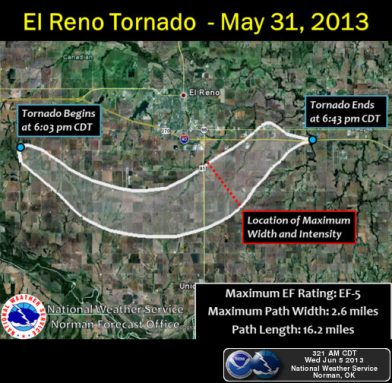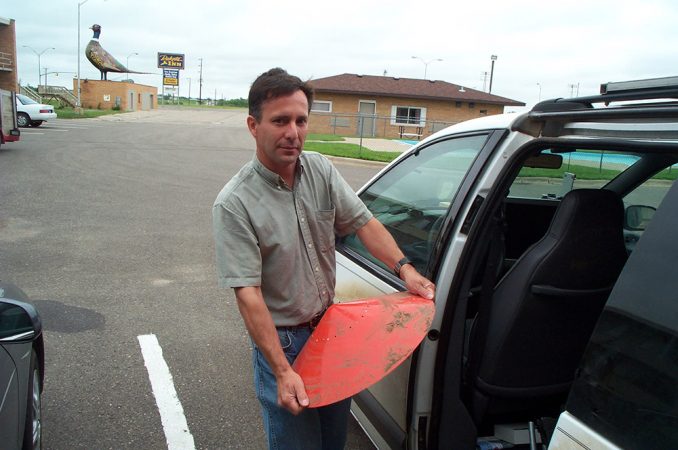Tornado caught storm chasers
Tim Samaras died doing what he loved — collecting tornado data for science
By Janet Raloff

It was the Wizard of Oz, and throughout its tornado scene the boy couldn’t take his eyes off of the twister. His only thought: “Dude — I’ve got to take that apart!” For much of the past two decades, this renowned tornado chaser attempted to do just that. But on May 31, the 55-year-old Samaras died in that quest. So did his 24-year-old son, Paul, and fellow storm chaser Carl Young. (Science News for Kids covered Samaras’ work in “Twister science” on Dec. 9, 2012.)
The three men were caught in what is now being described as a monster storm, the biggest U.S. twister in recorded history. It was a category F5 storm — the most intense class of tornadoes. It traveled a distance of 16.2 miles (26 kilometers) along a path just south of El Reno, Oklahoma. At one point, its width spanned 2.6 miles — surpassing the previous record. A more saddening record: The Samarases and Young are the first storm chasers known to be killed by a tornado, according to the National Oceanic and Atmospheric Administration in Norman, Okla.
Many storm chasers are thrill-seekers who chase tornadoes for the excitement of it all. Not Samaras. He was an engineer, meaning he used science to answer questions. And the ones Samaras probed focused on how tornadoes intensify, and at what heights their winds rev up most dramatically.
Meteorologists have long understood, at least generally, why tornadoes form. But their studies have focused on what happens high in the air. Knowledge about air movements near the ground — where twisters wreak their damage — remained somewhat fuzzy. At ground level, the physics can get very complicated. So back in 1999, Samaras proposed building new instruments. His goal: to essentially take a tornado’s pulse. He would measure atmospheric pressure, wind speeds and wind directions inside a twister. And he’d focus on features in the lowest 33 feet (roughly 10 meters).
When Samaras told other tornado researchers he planned to place his devices in the path of a twister, they scoffed. It had been tried, they said. No instruments can survive.
“Fortunately, I didn’t listen,” Samaras said. Through trial and error, he designed instruments that stayed put. This allowed some to map the three-dimensional wind fields inside a tornado — “because they don’t just move horizontally, but also vertically,” he noted.
He also collected data demonstrating a record-breaking 100-millibar pressure drop inside an F4 tornado. So the atmospheric pressure inside the twister was probably at least 10 percent lower than just outside the vortex — an astounding difference. And Samaras showed that the greatest acceleration of winds within a twister occurs right near the ground. One of his devices found evidence that wind speeds of 100 miles per hour (161 kilometers per hour) can occur just 6 inches (15 centimeters) above the ground.
A week before they died, Tim Samaras and Carl Young tracked the birth of a tornado in Kansas. Paul Samaras captured his dad explaining the event on video. The National Geographic Society believes this to be the most “complete” movie of a twister’s development. Credit: P. Samaras/ Nat. Geo. Soc.
Despite Samaras being thoughtful, cautious and very analytical, the May 31 tornado “got the best of him,” says John Francis. He’s the National Geographic Society’s vice president for Research, Conservation and Exploration in Washington, D.C. “Unfortunately, there are some things that are unpredictable — tornadoes and weather among them.” Samaras, of course, knew the risks. That’s why he focused on safety. He’s also far from alone in having chosen a risky field of research.
Certainly, many jobs are dangerous. No astronaut that rocketed into space was certain he’d return home safely. Many miners risk gas explosions and cave-ins to bring coal and other precious resources up from deep underground. Biologists have braved disease-carrying insects, perilous terrain and warring tribes to find new species. Geologists may climb up craters to study lakes of gurgling lava (some of which fling occasional deadly lava bombs) to better understand the internal plumbing of active volcanoes.
Every person who attempts to explore new environments across the depth and breadth of Earth’s surface faces challenges, says Francis. For most of them, it’s not the danger and excitement that drives them. It’s instead an intense curiosity — as Samaras described — to understand things better.

In 2003, Francis signed off on National Geographic’s first research grant to Samaras. It was to build and deploy devices to measure the pressure drop as a tornado passed over. Seventeen more grants over the years would help Samaras improve his tornado-monitoring devices and build novel instruments to study lightning.
But for all Samaras’ accomplishments, Francis says, most people will miss Samaras simply because he was “just a wonderful person — accomplishing things that no one else on the planet had.”
Power Words
lava bomb A clump of lava — molten rock — that can be flung up from a pool of lava at the top of a volcano, usually when a gas bubble bursts at the pool’s surface.
meteorologist Someone who studies weather and climate events.
millibar A unit of atmospheric pressure. The average pressure at sea level is around 1,000 millibars, or not quite 15 pounds per square inch (or roughly 1 kilogram-force per square centimeter).
tornado A violently rotating column of air extending from the ground to a thunderstorm above.
vortex A swirling whirlpool of some liquid or gas. Tornadoes tend to exemplify a vortex.







